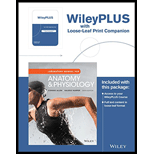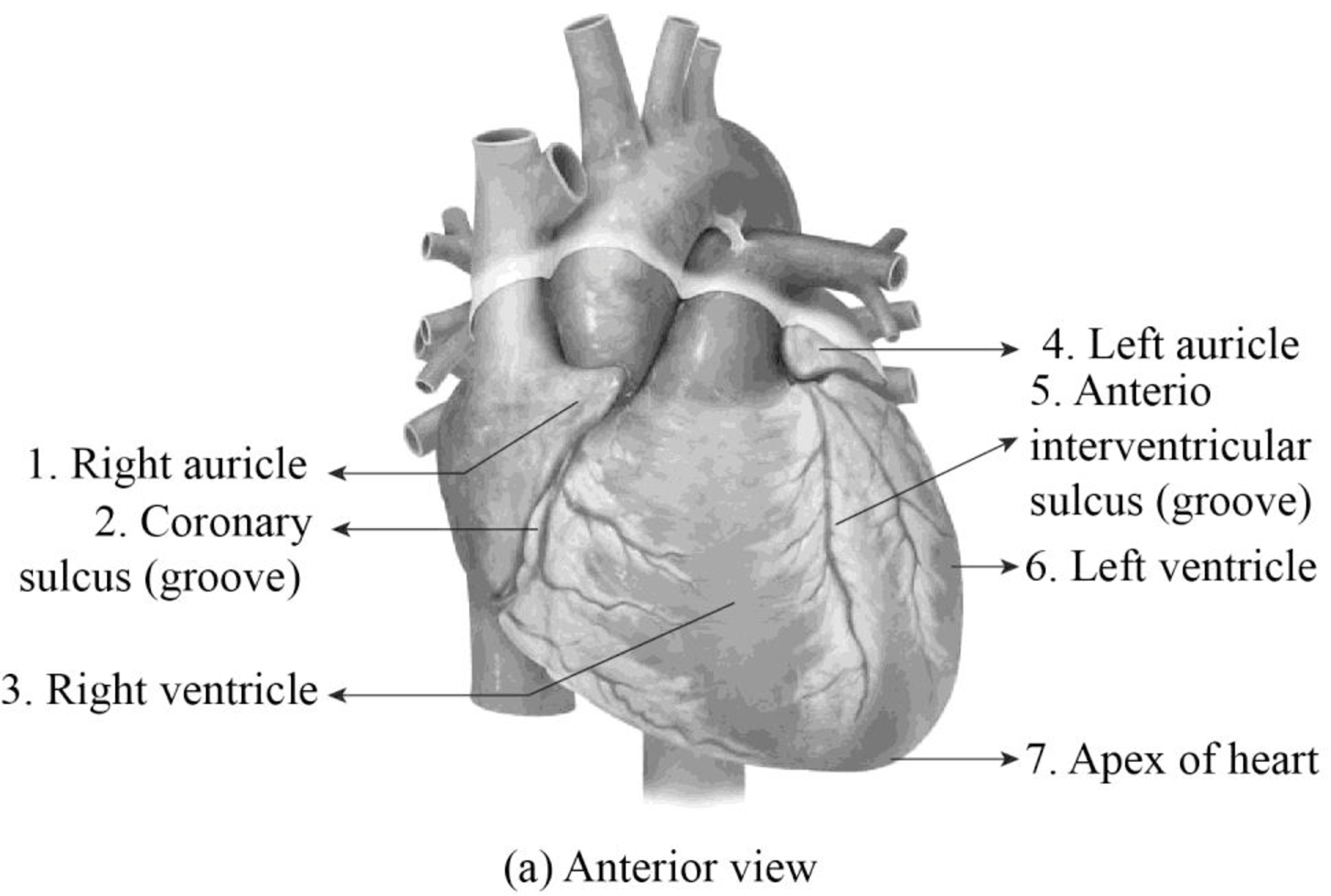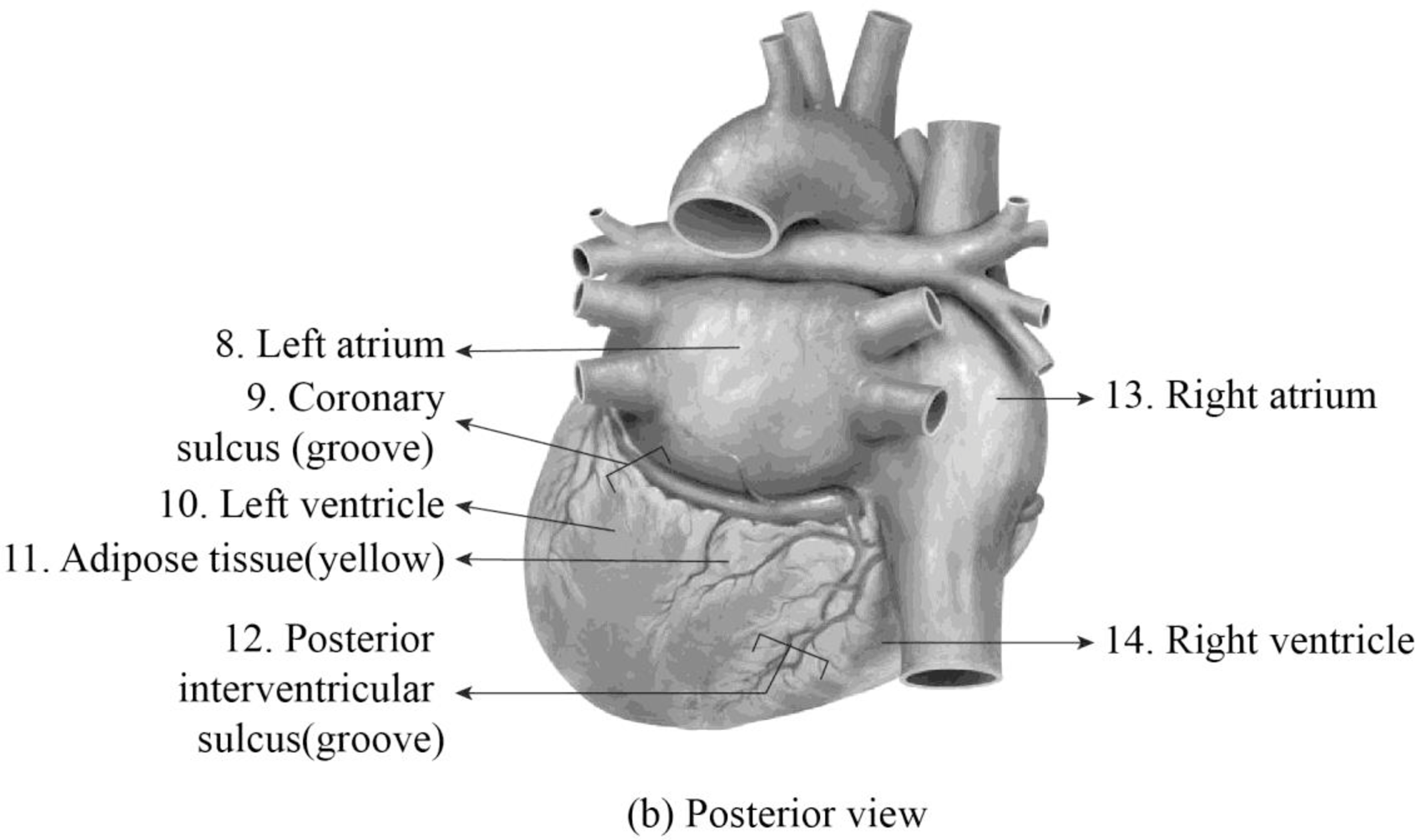
Concept explainers
(a)
To label: The heart structures in Figure 27.2(a)
Introduction: The heart is the muscular organ that weighs about the size of the fist. The main function of the heart is to transport the oxygenated blood to all parts of the body. It consists of four chambers namely right atrium, left atrium, right ventricle, and left ventricle. The blood vessels called arteries and veins are involved in the transport of blood to the tissues and from tissues to the heart.
(a)
Answer to Problem 1.1BGL
Pictorial representation:

Fig 1: The anterior view of the heart.
Explanation of Solution
The structures of the anterior view of the heart is reviewed as follows:
Right auricle: It is the muscular cone shaped pouch that is attached to the right atrium of the heart. It is also called as right atrial appendage.
Cononary sulcus: It is the structure that separates the atrium of the heart from the ventricles. There are two coronary sulcus present in the heart namely right coronary sulcus and left coronary sulcus.
Right ventricle: It is one of the four heart chambers. It plays an important role in carrying the deoxygenated blood from the heart to the lungs.
Left auricle: It is the muscular cone shaped pouch that is attached to the anterior surface of the left atrium of the heart. It functions in increasing the pumping capacity of the left atrium.
Anterior interventricular sulcus: The heart consists of two interventricular sulcus namely anterior interventricular sulcus and posterior interventricular sulcus. It plays an important role in separating the ventricles of the heart.
Left ventricle: It is one of the four heart chambers. It plays an important role in carrying the oxygenated blood to all parts of the body.
Apex of heart: It is present in the left side of the heart between the fourth and fifth ribs. It consists of the left ventricle. It plays an important role in regulating the contraction of the ventricles.
(b)
To label: The heart structures in Figure 27.2(b)
Introduction: The heart is the muscular organ that weighs about the size of the fist. The main function of the heart is to transport the oxygenated blood to all parts of the body. It consists of four chambers namely right atrium, left atrium, right ventricle, and left ventricle. The blood vessels called arteries and veins are involved in the transport of blood to the tissues and from tissues to the heart.
(b)
Answer to Problem 1.1BGL
Pictorial representation:

Fig 2: The posterior view of the heart.
Explanation of Solution
The structures of the posterior view of the heart is reviewed as follows:
Left atrium: It is one of the four heart chambers. The oxygenated blood from the lungs enters into the left atrium.
Coronary sulcus: It is the structure that separates the atrium of the heart from the ventricles. There are two coronary sulcus present in the heart namely right coronary sulcus and left coronary sulcus.
Left ventricle: It is one of the four heart chambers. It plays an important role in carrying the oxygenated blood to all parts of the body.
Adipose tissue: The adipose tissue that surrounds the heart plays an important role by acting as cushion and insulates the heart.
Posterior interventricular sulcus: The heart consists of two interventricular sulcus namely anterior interventricular sulcus and posterior interventricular sulcus. It plays an important role in separating the ventricles of the heart.
Right atrium: It is one of the four chambers of the heart that receives the deoxygenated blood from the vena cava and pumps to the right ventricle.
Right ventricle: It is one of the four chambers of the heart that sends blood to the lungs to get oxygenated through the pulmonary arteries.
Want to see more full solutions like this?
Chapter 27 Solutions
Laboratory Manual for Anatomy and Physiology, 6e Loose-Leaf Print Companion
 Human Anatomy & Physiology (11th Edition)BiologyISBN:9780134580999Author:Elaine N. Marieb, Katja N. HoehnPublisher:PEARSON
Human Anatomy & Physiology (11th Edition)BiologyISBN:9780134580999Author:Elaine N. Marieb, Katja N. HoehnPublisher:PEARSON Biology 2eBiologyISBN:9781947172517Author:Matthew Douglas, Jung Choi, Mary Ann ClarkPublisher:OpenStax
Biology 2eBiologyISBN:9781947172517Author:Matthew Douglas, Jung Choi, Mary Ann ClarkPublisher:OpenStax Anatomy & PhysiologyBiologyISBN:9781259398629Author:McKinley, Michael P., O'loughlin, Valerie Dean, Bidle, Theresa StouterPublisher:Mcgraw Hill Education,
Anatomy & PhysiologyBiologyISBN:9781259398629Author:McKinley, Michael P., O'loughlin, Valerie Dean, Bidle, Theresa StouterPublisher:Mcgraw Hill Education, Molecular Biology of the Cell (Sixth Edition)BiologyISBN:9780815344322Author:Bruce Alberts, Alexander D. Johnson, Julian Lewis, David Morgan, Martin Raff, Keith Roberts, Peter WalterPublisher:W. W. Norton & Company
Molecular Biology of the Cell (Sixth Edition)BiologyISBN:9780815344322Author:Bruce Alberts, Alexander D. Johnson, Julian Lewis, David Morgan, Martin Raff, Keith Roberts, Peter WalterPublisher:W. W. Norton & Company Laboratory Manual For Human Anatomy & PhysiologyBiologyISBN:9781260159363Author:Martin, Terry R., Prentice-craver, CynthiaPublisher:McGraw-Hill Publishing Co.
Laboratory Manual For Human Anatomy & PhysiologyBiologyISBN:9781260159363Author:Martin, Terry R., Prentice-craver, CynthiaPublisher:McGraw-Hill Publishing Co. Inquiry Into Life (16th Edition)BiologyISBN:9781260231700Author:Sylvia S. Mader, Michael WindelspechtPublisher:McGraw Hill Education
Inquiry Into Life (16th Edition)BiologyISBN:9781260231700Author:Sylvia S. Mader, Michael WindelspechtPublisher:McGraw Hill Education





